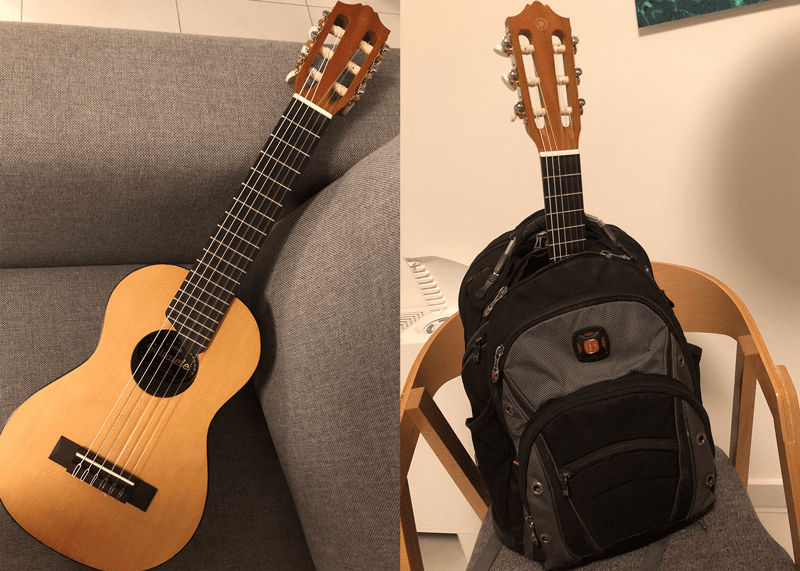by Dave Belcher
The “Guitalele”?
The guitar is but one member of a very large and extended family. Distant cousins of today’s guitar stretch back at least 3,000 years — though closer family resemblances date back only a few centuries. The oud was brought to the Iberian penisula by the Moors around the eighth century and evolved into the popular medieval European lute, viheula, and baroque guitar — perhaps the grandparents and parents of today’s beloved six-string instrument. However, there are also many recent additions to the guitar family. The ukulele, for instance, is a late-nineteenth-century cousin of the guitar originally from Portugal before making its way to the Hawaiian islands. An even more recent adoption is the Guitalele, or kīkū, a six-string hybrid of the ukulele and the modern guitar.
The guitalele (we’ll use that term for convenience throughout) is a fascinating instrument: it is about one-fourth the size of a traditional, modern guitar, but bigger than a ukulele, and has a similar tuning to the guitar but transposed up a fourth. What that means practically is that you can play the guitalele exactly like a guitar, but all notes will sound higher in pitch by an interval of a fourth (or, if you’re familiar with using a capo then it would be like having a capo on the fifth fret). The resulting tuning from low to high is ADGCEA. This makes the Guitalele an excellent option for a “travel guitar” because it’s small enough as not to be obtrusive but basically the same tuning as your “normal” guitar.
What about the “Kīkū“?
The more traditional name for the guitalele is “kīkū” and comes directly from Hawaiian culture. Traditional Hawaiian musician Zanuck Lindsey and cultural and Hawaiian language expert Nara Cardenas tell us about the roots of the term:
“The word Kīkū, as referenced in the ‘olelo noeau ‘Niihau i ke kīkū,’ means ‘independent.’ It is often used to praise a precocious or headstrong child and so the name carries with it the connotation of rebellion and, of innovation. Kīkū inspires bold visions of modern invention fused with a reverence for sovereign, indigenous dignity. It also is a play on words in the Hawaiian language for the word ‘kika‘ is a Hawaiianization for ‘guitar,’ but that’s where the similarity ends.
“Over time, though it is still an instrument in its infancy, it has been given many names including six string ukulele, guitalele, uketar, guke, etc. These unimaginative terms used to classify this groundbreaking instrument lack depth and nuance. Kīkū accurately describes its individuality, beauty, and lineage with our Hawaiian culture and love of nahenahe (soothing) music.”
Whatever term you decide to use, it is important to distinguish the guitalele/kīkū from other related instruments in the guitar family.
The Guitalele and the Requinto Guitar
Some of you who have played in guitar orchestras may be wondering what are the differences between a guitalele and the similar Latin American instrument, the requinto guitar. Like the guitalele, the requinto guitar similarly has six strings and is also tuned like the same as the guitalele. The body of the requinto guitar, however, is generally larger than the guitalele. Where the guitalele is usually around a 430mm scale length (compare with the “traditional” 650mm scale length of the guitar), the requinto guitar usually has a scale length of around 530mm.
This larger body and slightly larger scale length allow the requinto guitar to have more projection and resonance and make it a suitable instrument for guitar orchestra. Hence, you’ll often see guitar ensemble music that includes a part for the requinto guitar. While typically composers and arrangers will automatically transpose the requinto guitar part down a fourth so that, when played, it sounds in the same key as other traditionally tuned guitars, it is sometimes necessary for the requinto player to transpose the music on the fly as it were.
A guitalele could similarly be used for such purposes. Though it plays like a guitar (but sounds higher in pitch), when playing with other instruments the music will need to be tranposed so that the resulting key/pitch is the same as the other instrumentalists.
The guitalele is a fascinating instrument and it has many connections with both the traditional modern guitar and some of its ancestors — so I hope you’ll check it out more. Here’s a wonderful performance of J. S. Bach’s “Largo” from Violin Sonata no 3 in C Major (BWV 1005) — just in case you were wondering whether Bach can be played on guitalele:
You can find the Guitalele on Amazon


Thank you for that information and for the beautiful piece of music! I have played classical guitar a little and I love the guitarlele. Can you recommend a classical course for this instrument? Thank you Renee
Hi Renee,
I don’t know of a course dedicated specifically to playing classical on guitalele, no. But you might check out Ukulele Corner, taught by Jeff Peterson — it’s a wonderful site!
Peace,
Dave B (CGC team)